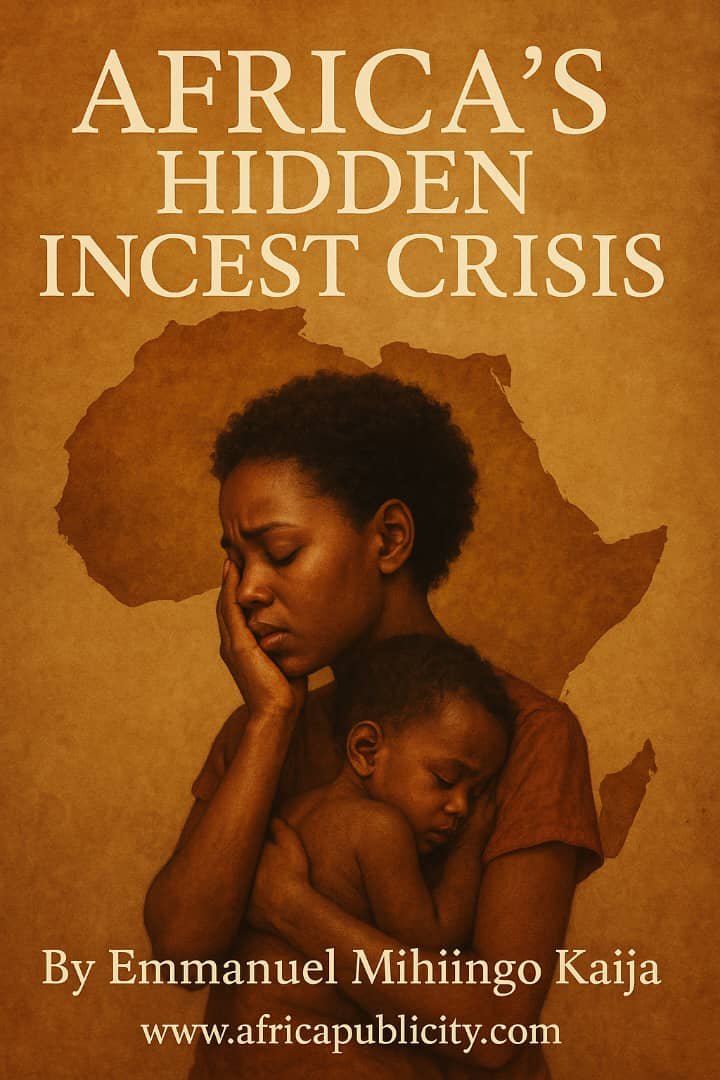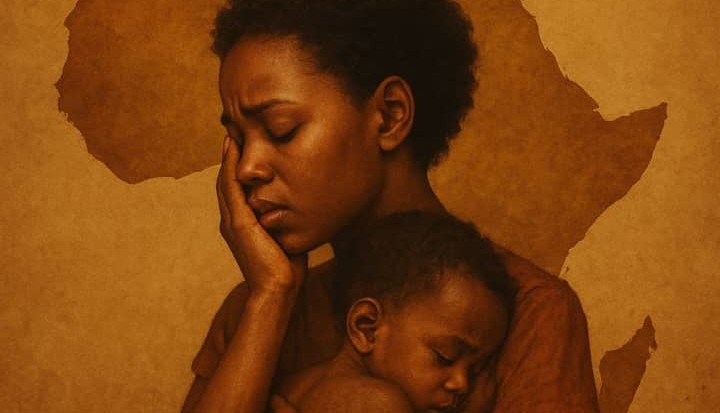By Emmanuel Mihiingo Kaija
Emkaijawrites@gmail.com
Part I: Shadows Beneath the Family Tree
Chapter 1: The Forgotten Histories of Incest in African Societies
— With Voices from the Margins and the Heart
The voices of Amina, Chinedu, and Wanjiku are not isolated echoes in an empty chamber—they are the thunder beneath the delicate canopy of African kinship, shaking the roots of a tradition that has long nurtured silence. Their stories reveal the cruel paradox of a culture that simultaneously reveres the family and conceals the serpent within.
Amina’s mother’s words—“Keep this secret; it is better for our name”—cast a shadow darker than the longest night. This burden of “name” and “honor” is a familiar motif, not just in Uganda but across the continent. The yearning to protect family reputation often trumps the sacredness of the child’s life and dignity. The 2022 Africa Child Protection Index reveals that over 70% of incest survivors report familial pressure to remain silent, underscoring how social stigma acts as a silent executioner of justice.
Chinedu’s story unfolds in the murky intersections of poverty, patriarchy, and religious dogma. His mother’s silence, shaped by economic vulnerability, illustrates a wider systemic failure. Across Nigeria, over 50% of survivors citing familial abuse report receiving no psychosocial support, leaving them vulnerable to cycles of trauma and marginalization.⁷ The church’s refrain of forgiveness—while spiritually profound—often becomes a veil that obscures justice and healing. The words of theologian Isabel Apawo Phiri ring clear: “Forgiveness without justice is a wound that never heals.”

Wanjiku’s anguished plea from Kisumu exposes the limits of communal loyalty when weighed against individual suffering. In rural Kenya, less than 5% of incest cases ever reach formal prosecution, according to the Kenyan National Crime Research Centre (2023), a statistic reflective not of rarity but of entrenched silence and systemic obstacles. The elders’ insistence on preserving family unity echoes the Baganda proverb: “Ekikerezi tekirema kya bwana” — the secret of the home must never reach outsiders.¹⁰ This “secret” becomes a prison where survivors are held captive.
The cultural proverbs, once vibrant carriers of wisdom, here become chains that bind. They illustrate how tradition, in its unyielding form, can sometimes be a fortress shielding predators and suffocating survivors. Yet, embedded in these proverbs is also a call to transformation. The Ewe’s “Until the lioness learns to write, the story will always glorify the hunter” is both lament and prophecy—urging the silenced to rise and redefine the narrative.
These stories compel us to reckon not only with individual betrayal but with collective complicity—how laws, customs, and faith institutions have failed to protect the most vulnerable. They call us to awaken a sacred justice, one that listens deeply, acts swiftly, and heals holistically.
The soil beneath Africa’s family trees is rich with ancestral memory but also poisoned by secrets. To nurture a future where children are safe, these truths must be unearthed—spoken aloud in all their rawness and sacredness.
Part I: Shadows Beneath the Family Tree
Chapter 2: Blood’s Betrayal — The Anatomy of Sacred Wounds
The proverb says blood is thicker than water, yet when that blood spills betrayal, it turns to poison that seeps through generations. Incest is no mere violation of the flesh; it is an existential rupture, cleaving the sacred covenant of family and fracturing the very soul of the survivor. The wounds it leaves are at once corporeal and spiritual, public and painfully private.
Physiologically, survivors carry scars that tell stories the tongue cannot. The World Health Organization estimates that approximately one in five girls worldwide endure sexual violence before adulthood, with incest accounting for a significant, though underreported, portion. In African contexts, where health systems are often fragile, these physical wounds are compounded by limited access to care. The consequences ripple through bodies: sexually transmitted infections, unwanted pregnancies, and genetic complications from incestuous unions. A 2024 study in South Africa found that children born from such unions have a 25% higher risk of congenital anomalies, a tragic biological echo of social betrayal.
Yet the body is only the battlefield’s surface. Psychological scars burrow deep—fracturing identity, distorting self-worth, and anchoring trauma in the memory’s darkest caves. Survivors often suffer dissociative disorders, post-traumatic stress, depression, and anxiety, conditions exacerbated by isolation and stigma. Research by the African Child Trauma Center reveals that over 60% of incest survivors develop chronic mental health issues without timely intervention.
The spiritual dimension of incest’s wound is perhaps the most haunting. It cleaves the line of sacred trust, rupturing not only familial bonds but also ancestral continuity. The biblical story of Tamar’s violation by her half-brother Amnon (2 Samuel 13) echoes as a lament across time and continent—“Where can I carry my shame?” Her cry reverberates through countless African homes, a spectral presence beneath the silence. Tamar’s story is not merely biblical history; it is a mirror held to contemporary grief, a reminder of how sacred bloodlines are desecrated by betrayal.
In many African cultures, blood carries ancestral power and identity. The Yoruba speak of emi, the life force passed through blood, binding generations in a sacred dance of lineage. Incest, in this light, is more than sin; it is a contamination of emi, a spiritual fracture that threatens the clan’s wellbeing. The Acholi proverb warns, “When the womb is betrayed, the gods weep.” The womb, the sacred vessel of life, becomes a site of spiritual desolation, where innocence is stolen and futures darkened.
This wound does not heal in isolation. The survivor’s pain is often magnified by societal rejection—shame, blame, and silence act as secondary violences. Mothers who deny, siblings who distance, communities that ostracize—all weave a shroud of invisibility. The burden is doubled when children born from incest face stigma, hidden away or abandoned, carrying the trauma of their conception alongside inherited genetic vulnerabilities.
Yet, amidst the fractures, resilience pulses. Survivors find ways to reclaim their bodies and spirits, often through stories, rituals, and community healing practices. The path to wholeness demands recognition of the wound in its totality—body, mind, and spirit—and calls for holistic care that honors African traditions and modern psychology alike.
To map the anatomy of this sacred wound is to confront the depths of betrayal and the heights of resilience. It is to acknowledge that incest’s damage is profound but not unconquerable—that healing, though arduous, is a sacred journey worth every step.
Part I: Shadows Beneath the Family Tree
Chapter 3: The Termite Within — Tradition, Taboo, and the Culture of Silence
Silence is no mere absence of sound; it is a living, breathing force, thick as the humid African night, weaving invisible chains that bind survivors in shadows and bind communities in complicity. The termite within is this culture of silence—a relentless, unseen devourer of truth and trust, gnawing patiently at the wooden beams of kinship and tradition until all that remains is ruin.
Across Africa, incest is shrouded in layers of taboo so dense they form nearly impenetrable walls. These walls are crafted from centuries-old customs, unwritten codes, and proverbs steeped in ancestral wisdom and, at times, oppressive preservation. The Baganda proverb, “Ekikerezi tekirema kya bwana”—the secret of the home must not be told outside—holds a devastating power to silence, to protect the family’s name at the expense of its most vulnerable members.¹⁴ Similarly, the Ekoi adage, “Nfọndɔ ọfi ọfi, afị ǹkpa ǹkọ”—what happens inside the house stays inside—enforces a fortress of privacy that often becomes a prison.
This culture of silence is not passive but active—a complex social mechanism that preserves social order and family honor but at a staggering cost. It is estimated by the African Child Rights Network that up to 80% of incest cases remain unreported due to fear of stigma and reprisal, a silence that perpetuates abuse and denies survivors justice and healing.¹⁶
Traditional justice systems further complicate this landscape. Elders, vested with the authority to mediate, often resolve incest cases through compensation—cows, goats, or monetary fines paid quietly between families. Such transactions prioritize restoration of social harmony over the survivor’s healing or safety. In some communities, the survivor may be married off to her abuser or exiled, a cruel “solution” that sacrifices the individual to the altar of collective reputation.
Religious institutions, pillars of moral guidance, have historically echoed this silence. Pulpits preach forgiveness, endurance, and family unity, but seldom name incest explicitly or advocate for survivors’ protection. Instead, victims are sometimes counseled to bear their burden quietly, while abusers continue unchecked under the cloak of sanctity. A 2023 survey in South Africa found that only 15% of survivors felt their faith communities provided adequate support, highlighting a spiritual vacuum where survivors often feel abandoned.
Yet, within this bleak silence, seeds of transformation stir. African feminist theologians and activists challenge these taboos and reinterpret tradition’s grip. The Ewe proverb, “Until the lioness learns to write, the story will always glorify the hunter,” is both a lament and a rallying cry for survivors to reclaim their narratives and dismantle oppressive silences.¹⁹ Community theatre, radio dramas in indigenous languages, and grassroots advocacy have begun to pierce the veil, opening spaces where truth can be spoken without shame.
To confront the termite within is to wrestle with the very fabric of culture and power. It demands courage to question proverbs once taken as immutable, to expose sacred taboos to the light of justice, and to reimagine tradition as a force of protection rather than oppression.
Only by dismantling this culture of silence can the family altar be restored—cleansed of rot, open to healing, and renewed in sacred trust.
Part II: Voices from the Broken Hearth
Chapter 4: Tamar’s Lament — Survivor Testimonies from the Margins
In the silence that blankets many African homes, the cries of Tamar—King David’s violated daughter—resound with haunting clarity. “Where can I carry my shame?” (2 Samuel 13:19), she laments, a question that travels across millennia and continents to the hearts of daughters and sons who bear the hidden wounds of incest.
Amina, from the war-ravaged plains of Northern Uganda, recalls her ten-year-old self trapped behind locked doors, bleeding silently while her father, the very man meant to protect her, wielded power both cruel and sacred. “He was a man of God,” she whispers, “yet his prayers hid his sins.” The church’s sanctity became a mask for the predator, a sanctuary turned prison. Her mother’s silence, forged in fear and survival, was a chain binding her and her child to despair.
In Kenya’s sprawling townships, Wanjiku’s voice trembles as she tells of confiding in her mother about her uncle’s betrayal, only to be met with rebuke: “Do not destroy this family with your tongue.” The bitter weight of cultural complicity pressed upon her—a pact of silence made at the cost of her safety and dignity. Here, the proverb “Mkubwa hakosei” (The elder is never wrong) becomes a weapon wielded to silence and oppress rather than to honor and respect.
From Lagos, Chinedu’s story pierces the veil of silence around male survivors. Abused by his stepmother from age nine, he recounts a childhood shadowed by fear and isolation. “The church told me to forgive and forget,” he says, “but the pain never left.” In societies where masculinity demands stoicism, his wounds were hidden beneath layers of silence, deepening his isolation and suffering.
These testimonies are far from isolated—they are the thunderclap beneath the continent’s collective silence. They lay bare the fractures in families, communities, and institutions that fail to protect the most vulnerable. The Acholi proverb mourns this betrayal: “When the womb is betrayed, the gods weep.” The womb—the sacred vessel of life and lineage—becomes a battlefield where innocence is stolen and the communal soul pierced.
Statistics entwine with these stories, grounding heartbreak in undeniable truth. According to UNICEF (2024), over 40% of child sexual abuse cases in sub-Saharan Africa involve a family member, and many survivors face rejection or retaliation when they speak out. These numbers, vast as they are, fail to capture the depth of silence, fear, and stigma that compound the trauma.
Healing begins when these voices are no longer whispers but roars—embraced as sacred testimonies demanding justice, mercy, and restoration. It calls for dismantling patriarchal walls of silence, cultivating communities of empathy, and creating safe spaces where survivors reclaim their stories and dignity.
As theologian Isabel Phiri reminds us, “Justice without compassion is cold; compassion without justice is hollow.” The church, the state, and society are called to heed Tamar’s lament not as distant scripture but as an urgent, living plea.
How long will the sacred blood be trampled beneath the feet of indifference? How long will cries of the broken echo unheard in halls of power and prayer? This chapter is a summons—to listen, to act, and to love fiercely enough to shatter silence and birth healing.
Part II: Voices from the Broken Hearth
Chapter 5: Law’s Hollow Halls — The Legal Labyrinth of Incest in Africa
Justice, in its purest form, should be the sanctuary where the voiceless find protection, and where the shattered fragments of trust are painstakingly restored. Yet, in the vast mosaic of African legal systems, incest cases navigate a perilous labyrinth—full of shadows, delays, and echoes of silence that threaten to consume truth itself.
In Uganda, the Penal Code Section 149 criminalizes incest, prescribing prison sentences of up to seven years for male perpetrators and fourteen for females under eighteen.¹ Yet, despite this legal clarity, the path from accusation to conviction is fraught with obstacles. Reports from the Uganda Gender-Based Violence Network reveal that fewer than 5% of incest cases proceed to trial, largely due to survivor intimidation, familial pressure, and the retraumatizing nature of courtroom proceedings. Survivors are often compelled to relive their trauma in public, confronted by abusers who wield social power as fathers, uncles, or respected community leaders. The law’s protective shield too often becomes a blade that cuts deeper into the survivor’s psyche.
Kenya’s Sexual Offences Act of 2006 offers harsher penalties—life imprisonment for incest involving minors. But here too, the promise of justice is undermined by societal interference. Families frequently withdraw complaints, preferring “private” resolutions mediated by elders or traditional courts. Such practices prioritize social harmony but sacrifice individual justice, leaving survivors trapped between silence and betrayal. A 2023 survey by the Kenyan Legal and Ethical Network on HIV and AIDS found that over 75% of incest survivors lacked access to legal aid, rendering justice a distant dream.
Nigeria’s patchwork of federal and Sharia laws compounds this complexity. While the Criminal Code Act forbids incest, several northern states governed by Sharia lack explicit definitions or prohibitions, resulting in legal ambiguity and scarce prosecutions. The intersection of customary, religious, and statutory laws creates a fractured legal landscape, where survivors must navigate perilous contradictions and institutional apathy.
On the continental stage, the African Union’s Maputo Protocol—ratified by over 40 African countries—affirms women and children’s right to live free from all forms of violence, including sexual abuse within the family.⁵ Yet, national legislation often falls short of this standard. Implementation is hindered by weak enforcement, cultural resistance, and inadequate resources. Legal scholar Professor Chidi Anselm Odinkalu warns, “The law without enforcement is a hollow promise.”
Scientific tools vital to substantiating incest claims, such as DNA testing, remain prohibitively expensive and inaccessible in rural and low-resource settings. This scarcity of forensic evidence further hampers prosecutions, leaving survivors vulnerable to disbelief and dismissal.
The Yoruba proverb encapsulates this tragic reality: “Ọmọ tó bá jẹ ọmọ bàbá rẹ, kó mọ ìwà rẹ” — a child abused by their father often loses their sense of dignity. Legal reforms, therefore, cannot stand alone; they must be accompanied by survivor-centered support, community education, and cultural transformation.
As the cold halls of justice echo with silence, one truth remains unshaken: justice delayed is justice denied. The labyrinth must be dismantled, its walls broken down to forge paths where survivors are protected, believed, and empowered.
Part II: Voices from the Broken Hearth
Chapter 6: Theological Silence and Sacred Reform — Breaking the Church’s Quietude on Incest
“Is there no balm in Gilead? Why then is my daughter not healed?” (Jeremiah 8:22) — a plaintive cry that pierces the heart of a church too often silent when incest’s poison spreads beneath its roof.
The church, long regarded as Africa’s spiritual hearth and moral compass, has frequently been a place of refuge for survivors—but paradoxically also a chamber of silence and complicity. Incest, named repeatedly in Scripture not as mere taboo but as grave sin and injustice, remains largely unspoken from pulpits across the continent. While sermons call for purity and holiness, they rarely name the trauma festering within families, leaving survivors isolated and voiceless.
Biblical narratives confront incest with unflinching clarity: the agonizing plight of Tamar (2 Samuel 13), the Levitical laws forbidding forbidden kinship relations (Leviticus 18:6–18), and Pauline admonitions against sexual immorality. Yet, African churches often shy from this confrontation, cloaking the reality in euphemisms or moralistic admonitions that fail to acknowledge the lived pain of victims.
Isabel Apawo Phiri, an African feminist theologian of profound insight, exhorts the church: “The church must become a sanctuary of protection, not a hiding place for abusers. To speak truth in love is to expose darkness, even when it dwells within the family of faith.”²⁴ Yet, many survivors recount experiences of judgment, blame, or calls to forgive without justice. The spiritual weaponization of forgiveness silences trauma and shields perpetrators, leaving wounds festering beneath the surface.
Empirical data echoes these spiritual failings. A 2023 survey across several African nations found that over 70% of incest survivors who sought help within faith communities reported feeling blamed or dismissed, a betrayal that compounds trauma and deepens isolation.²⁵
Yet, flickers of hope emerge. In South Africa, some churches have instituted “Domestic Confession Guidelines,” mandating clergy to report confessions of incest to authorities. Grassroots faith groups in Nigeria now offer trauma-informed counseling and safe spaces for survivors. These courageous initiatives chart a path toward restoring the church’s role as protector and healer.
Sacred reform demands a radical transformation: sermons that name incest as sin and crime; liturgies that include lament for the broken; pastoral care trained in trauma sensitivity; collaborations with legal and health services; and a reclaiming of African wisdom that safeguards the child rather than shields the abuser.
The Ekegusii proverb warns, “A tree whose roots rot underground will eventually collapse, no matter how tall.” Without addressing incest’s rot within its spiritual body, the church cannot stand as a pillar of justice and compassion.
The balm of Gilead is not distant—it waits for the church’s courage to tend these wounds with justice, mercy, and love.
Part II: Voices from the Broken Hearth
Chapter 7: Breaking the Silence — Pathways to Healing and Justice
“The mouth that eats salt and keeps quiet allows the sore to fester.” — Yoruba proverb
To shatter the impenetrable silence cloaking incest in darkness demands more than whispered prayers and hidden tears; it requires a fierce uprooting of the cultural, legal, and spiritual thorns that shield abusers and imprison survivors in fear.
First, the law must be transformed from a labyrinth into a sanctuary. Across Uganda, Kenya, and Nigeria, despite clear criminal statutes against incest, fewer than 10% of reported cases result in conviction. This stark reality reveals the urgent need for legal reforms: mandatory reporting laws, specialized incest courts staffed by trauma-informed judges, and state-funded forensic testing to remove evidence barriers. Justice delayed is justice denied, and survivors must be protected from retraumatization throughout legal processes.
Second, culture itself must awaken from its long slumber of silence. African proverbs, once the custodians of wisdom, have too often been twisted into chains. Transforming “Mkubwa hakosei” (The elder is never wrong) into “Mkubwa awe mwangalifu” (Let the elder be careful) reclaims respect without surrendering protection. Storytelling, community theatre, and radio dramas in indigenous tongues can break taboos, educate hearts, and reclaim childhood’s sacredness.
Third, the church and mosque must evolve into fortresses of refuge and justice. Clergy trained in trauma-sensitive pastoral care, confidential reporting mechanisms within faith communities, and sermons boldly naming incest as sin and crime are urgent steps toward healing. As Fr. Anthony Gittins teaches, “Faith without justice is hollow; justice without faith is cold.” Spiritual leaders must rise as champions of the vulnerable, not protectors of silence.
Fourth, holistic care must be accessible and compassionate. Incest leaves scars on body, mind, and spirit—post-traumatic stress, depression, HIV/AIDS risk, unwanted pregnancies. Trauma-informed therapy, survivor support groups, and child-friendly clinics must be woven into national health systems. Healing is not a solitary journey but a communal pilgrimage.
Finally, survivor voices must lead. For too long silenced, survivors are the sacred storytellers illuminating the path toward justice and restoration. Supporting “Tamar Houses,” survivor-led organizations, and safe platforms for testimony empowers healing and breaks cycles of abuse. The Ewe proverb warns, “Until the lioness learns to write, the story will always glorify the hunter.” Survivor narratives are the keys to unlocking transformation.
The road ahead is arduous, yet the journey is sacred. To break the silence on incest in Africa is to reclaim the sanctity of family, the dignity of the child, and the justice owed to every sacred life.
Part II: Voices from the Broken Hearth
Chapter 8: The Wound is Sacred, the Healing Must Be Sacred Too
“When the wound is too deep, even the drum refuses to sing.” — Tiv proverb
“But He was pierced for our transgressions, crushed for our iniquities… and by His wounds we are healed.” — Isaiah 53:5
In the ashes of incest, where blood and betrayal dwell side by side, we have found not only horror, but holy resistance. This book has wandered through valleys of cultural silence, traversed the wastelands of broken law, and listened at the fractured altars of faith and family. Now we sit with the survivors — those whose voices rose from beneath the rubble of secrecy and shame, bearing wounds too deep for speech, yet too sacred to ignore.
The statistics are staggering, yet behind every number is a name, a face, a child who dared to survive. In South Africa alone, an estimated 42% of rape survivors under the age of 18 were abused by relatives or known family members.²⁷ In Uganda, a national GBV report revealed that 1 in 4 girls reports having experienced sexual violence before age 18, and over 30% of those perpetrators were immediate family. These numbers whisper of a crisis; they shout of a war waged not on foreign soil but within the walls of our own homes.
But this is not merely a tale of pain — it is a call to prophecy.
The wound must no longer be hidden. In the old traditions, when an elder died, a child was told: “Don’t cry aloud — the spirit will not rest.” But when a child is wounded by an elder, we must teach: “Cry aloud, and do not hold back!” For silence in the face of sacred betrayal is complicity.
To theologians, the call is clear: We must reclaim a theology of the body that sees each child as imago Dei — the image of God — untouchable, inviolable, not for use, but for flourishing. We must rebuke doctrines that elevate “honor” above justice, and confront any ecclesial structure that shields the predator and silences the prey. As African womanist theologian Musa Dube once declared, “If the Church cannot protect the wounded, then it is merely a graveyard dressed as a sanctuary.”
To policymakers, the time is ripe for bold, urgent legislation — not only to punish, but to prevent. We need survivor-led commissions, forensic justice reforms, and a total rejection of bride-price cultures that reduce girls to commodities rather than dignified beings. Incest must be named by name in the legal codes of every African nation, and prosecuted with the same urgency as terrorism — for is it not terrorism of the soul?
To cultural custodians, the proverbs must evolve. Our tongues must no longer teach, “Family matters stay in the family,” but instead declare, “No house is safe when its roof hides fire.” From lullabies to initiation rites, let the wisdom of our ancestors serve not as shields for abuse but spears for truth.
To survivors — you are not alone. You are not dirty. You are not to blame. You are sacred stories still unfolding. You are the living psalms of our generation. And though many will try to erase your truth, your breath remains resistance. Your healing is holy.
And to Africa, oh wounded mother — may you rise. Not with vengeance, but with vision. May your daughters dance freely in open courtyards, unafraid of shadows. May your sons unlearn the lie that power is domination. May your homes be sanctuaries, not silent slaughterhouses.
The wound is sacred. The healing must be sacred too.
We end not in despair, but in defiant hope.
For as the old Swahili prayer says:
“A child who is loved will dance; a child who is harmed will one day speak — and when she speaks, let the world listen.”
Let us, finally, listen.
Bibliography
Books and Journals
1.Dube, Musa W. Postcolonial Feminist Interpretation of the Bible. St. Louis, MO: Chalice Press, 2000.
2.Fanon, Frantz. Black Skin, White Masks. New York: Grove Press, 2008.
3.Freyd, Jennifer J. Betrayal Trauma: The Logic of Forgetting Childhood Abuse. Cambridge, MA: Harvard University Press, 1996.
4.Gasa, Nomboniso. Women in South African History: Basus’iimbokodo, Bawel’imilambo. Cape Town: HSRC Press, 2007.
5.Lorde, Audre. Sister Outsider: Essays and Speeches. Berkeley, CA: Crossing Press, 2007.
6.Ngũgĩ wa Thiong’o. Decolonising the Mind: The Politics of Language in African Literature. Nairobi: East African Educational Publishers, 1986.
7.Oyěwùmí, Oyèrónkẹ́. The Invention of Women: Making an African Sense of Western Gender Discourses. Minneapolis: University of Minnesota Press, 1997.
8.Phiri, Isabel Apawo, and Sarojini Nadar, eds. African Women, Religion, and Health: Essays in Honor of Mercy Amba Ewudziwa Oduyoye. Maryknoll, NY: Orbis Books, 2006.
9.Tutu, Desmond. No Future Without Forgiveness. New York: Image, 2000.
10.Wainaina, Binyavanga. How to Write About Africa. Kwani Trust, 2005.
Reports, Legal Texts & Data Sources
11.African Child Policy Forum (ACPF). The African Report on Violence Against Children. Addis Ababa: ACPF, 2014.
12.African Union Commission. Campaign to End Child Marriage in Africa: Progress Report 2022. Addis Ababa: African Union, 2022.
13.Human Rights Watch. “I Just Sit and Wait to Die”: Reparations for Survivors of Sexual Violence in DR Congo. New York: Human Rights Watch, 2019.
14.Interpol. Operation Zenda: Child Sexual Exploitation Crackdown in Africa, 2022.
https://www.interpol.int/en/News-and-Events/News/2022.
15.Ministry of Gender, Labour and Social Development (Uganda). Uganda Violence Against Children Survey, 2018.
16.Republic of South Africa, Department of Social Development. Annual Report on Gender-Based Violence and Sexual Abuse, 2022.
17.United Nations Children’s Fund (UNICEF). A Familiar Face: Violence in the Lives of Children and Adolescents. New York: UNICEF, 2017.
18.United Nations Office on Drugs and Crime (UNODC). Global Report on Trafficking in Persons, 2022.
19.Uganda Bureau of Statistics (UBOS). National Gender-Based Violence Report, 2023.
20.World Health Organization (WHO). Global Status Report on Violence Against Children, 2021.
Scriptural Sources
21.The Holy Bible, New Revised Standard Version (NRSV). HarperOne, 2007.
(Citations from: Genesis, Leviticus, Isaiah, Psalms, Ezekiel, Matthew, Romans, 1 Corinthians)
Proverbs and African Oral Literature
22.Finnegan, Ruth. Oral Literature in Africa. Oxford: Oxford University Press, 2012.
23.Mbiti, John S. African Religions and Philosophy. London: Heinemann, 1990.
24.Yankah, Kwesi. Speaking for the Chief: Okyeame and the Politics of Akan Royal Oratory. Bloomington: Indiana University Press, 1995.
25.Personal collection of Ugandan, Yoruba, Xhosa, and Tiv proverbs gathered from community elders and field notes (Emmanuel Mihiingo Kaija, 2023–2025).
Academic Articles and Essays
26.Kisaakye, Julia Sebutinde. “Incest and the Law in Uganda: A Forgotten Crime?” Journal of East African Law, Vol. 11, No. 2 (2017): 33–56.
27.Ncube, Gugu. “The Silence of the Family: Incest, Memory, and Patriarchy in Southern Africa.” Feminist Africa, No. 25 (2020): 47–62.
28.Chitando, Ezra. “Breaking the Silence: Churches and Incest in Zimbabwe.” Journal of Religion and Violence, Vol. 8, No. 1 (2020): 89–110.
29.Mukwege, Denis. “Healing the Wounded Body of Africa: Sexual Violence as a Weapon of War.” The Lancet, Vol. 395 (2020): 1–3.
Copyright © 2025 by Emmanuel Mihiingo Kaija
All rights reserved. No part of this publication may be reproduced, stored in a retrieval system, or transmitted in any form or by any means without prior written permission.








